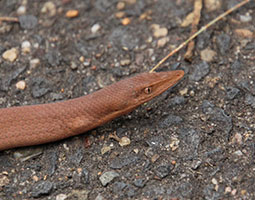Lialis burtonis
Description

Burton's Snake Lizard (Lialis burtonis) belong to the same family as geckos and are not venomous, even though they have the appearance of a snake. They use their elongated snout to suffocate prey by squeezing it around the neck and chest prior to consuming prey whole, head-first. They are both day-time and nocturnal hunters.
This species of lizard mate from September to January and lay 1-3 tough leathery eggs from November to January. Females typically lay their eggs under rocks and logs, on the ground, under leaf litter and occasionally in sugar ant nests.
Burton's Snake Lizard utilises a huge range of habitat types preferring low vegetation such as grasses, and beneath rocks, logs and ground debris. In particular they prefer dense leaf litter where they can bury themselves at various depths to maintain a constant body temperature and remain hidden at the same time.
Adaptations
- An elongated snout and pointed, hinged and recurved teeth, that assists it to grip its prey, large eyes enable them to see at night, find prey and avoid predators
- Binocular vision which enable it to strike with greater accuracy
- Flexible joints in its jaws which allow it to encircle prey
- Uses its tail to mimic worm movements and attract unsuspecting prey
- If it is seized by a predator it can drop its tail like many other lizards
- Camouflaging colouration to blend into leaf litter
Feeding relationships
- What I eat: Lizards (mainly other skinks but also other legless lizards, geckoes etc.)
- What eats me: Kookaburra, Lace Monitor, Gold crowned snake, Butcher Birds, Brown Goshawk, Pacific Baza, Fox, Cat and Dogs
Interesting facts
Burton's Snake Lizard is Australia's most widespread reptile and inhabits almost all Australian ecosystems with few exceptions.